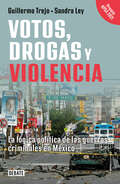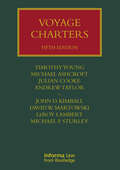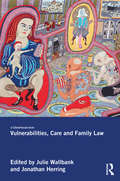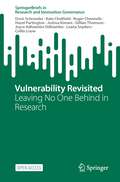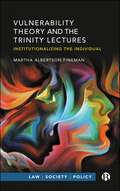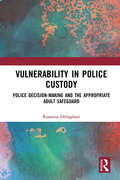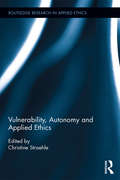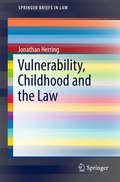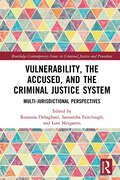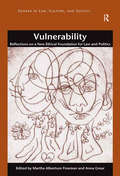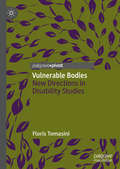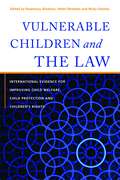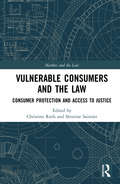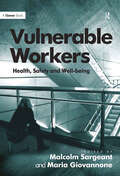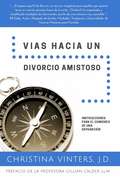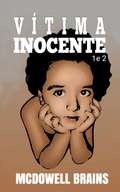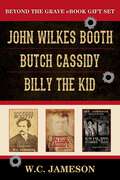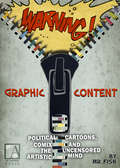- Table View
- List View
Votos, drogas y violencia
by Guillermo Trejo¿POR QUÉ A MEDIDA QUE LA DEMOCRACIA SE HA CONSOLIDADO EN MÉXICO LA VIOLENCIA A GRAN ESCALA SE HA MULTIPLICADO?. Guillermo Trejo y Sandra Ley ofrecen en este libro una teoría novedosa y necesaria sobre la violencia criminal, que enfatiza la influencia crucial de la política. A partir de estudios de caso en profundidad y análisis estadísticos que abarcan más de dos décadas y distintos niveles de gobierno, muestran que los procesos de transición democrática, aunados a la fragmentación del poder político, pudieron ser la causa principal del estallido e intensificación de las guerras en México, así como su expansión a las esferas de la política local y la sociedad civil. A diferencia de estudios previos, que ven a los grupos de crimen organizado como empresas económicas libres que operan en oposición a las autoridades estatales, Trejo y Ley los conciben como grupos ilegales íntimamente relacionados con el Estado. Por tanto, estos grupos responden al cambio político: el crimen organizado no puede existir ni operar con éxito si no cuenta con algún grado de protección estatal. Los autores denominan a esa intersección colaborativa zona gris, un espacio donde los grupos criminales pueden respirar, crecer, reproducirse y triunfar. Sin embargo, cuando la esfera del poder estatal cambia, el equilibrio de la zona gris también lo hace y eso genera violencia. Votos, drogas y violencia propone un nuevo enfoque político que amplía nuestra comprensión del crimen organizado y de las condiciones que propician la guerra y la paz en el inframundo criminal.
Voyage Charters (Lloyd's Shipping Law Library)
by Andrew Taylor Michael Ashcroft John Kimball Julian Cooke David Martowski LeRoy Lambert Michael Sturley Tim YoungWidely regarded as the leading authority on voyage charters, this book is the most comprehensive and intellectually-rigorous analysis of the area, is regularly cited in court and by arbitrators, and is the go-to guide for drafting and disputing charterparty contracts. Voyage Charters provides the reader with a clause-by-clause analysis of the two major charterparty forms: the Gencon standard charterparty contract and the Asbatankvoy form. It also delivers thorough treatment of COGSA and the Hague and Hague-Visby Rules, a comparative analysis of English and United States law, and a detailed section on arbitration awards. Key features of the fourth edition: The only textbook to deal specifically with this key area of maritime law Written by an impressive team of highly-regarded maritime authorities from both sides of the Atlantic Contains a wealth of updated English and American case law and arbitrations, as well as addressing broader issues such as Rome II Regulation Convention regarding the conflict of laws Practical user-friendly guide, which is accessible not only to lawyers but also shipping professionals A new, detailed United States law section on COGSA This book is an indispensable, practical guide for both contentious and non-contentious shipping law practitioners, and postgraduate students studying this area of law.
Voyage Charters (Lloyd's Shipping Law Library)
by Andrew Taylor Michael Ashcroft John Kimball Julian Cooke David Martowski LeRoy Lambert Michael Sturley Tim YoungWidely regarded as the leading authority on voyage charters, this book is the most comprehensive and intellectually-rigorous analysis of the area, is regularly cited in court and by arbitrators, and is the go-to guide for drafting and disputing charterparty contracts. Voyage Charters provides the reader with a clause-by-clause analysis of the two major charterparty forms: the Gencon standard charterparty contract and the Asbatankvoy form. It also delivers thorough treatment of COGSA and the Hague and Hague-Visby Rules, a comparative analysis of English and United States law, and a detailed section on arbitration awards. This book is an indispensable, practical guide for both contentious and non-contentious shipping law practitioners, and postgraduate students studying this area of law.
Voyage Charters (Lloyd's Shipping Law Library)
by Andrew Taylor Michael Ashcroft John Kimball Julian Cooke David Martowski LeRoy Lambert Michael Sturley Tim YoungWidely regarded as the leading authority on voyage charters, this book is the most comprehensive and intellectually-rigorous analysis of the area, is regularly cited in court and by arbitrators, and is the go-to guide for drafting and disputing charterparty contracts.Voyage Charters provides the reader with a clause-by-clause analysis of the two major charterparty forms: the Gencon standard charterparty contract and the Asbatankvoy form. It also delivers thorough treatment of COGSA and the Hague and Hague-Visby Rules, a comparative analysis of English and United States law, and a detailed section on arbitration awards.This book is an indispensable, practical guide for both contentious and non-contentious shipping law practitioners, and postgraduate students studying this area of law.
Voyeur Nation: Media, Privacy, and Peering in Modern Culture
by Clay CalvertFrom 24-hour-a-day "girl cam" sites on the World Wide Web to trash-talk television shows like "Jerry Springer" and reality television programs like "Cops," we've become a world of voyeurs. We like to watch others as their intimate moments, private facts, secrets, and dirty laundry are revealed. Voyeur Nation traces the evolution and forces driving what the author calls the 'voyeurism value. ' Calvert argues that although spectatorship and sensationalism are far from new phenomena, today a confluence of factors-legal, social, political, and technological-pushes voyeurism to the forefront of our image-based world. The First Amendment increasingly is called on to safeguard our right, via new technologies and recording devices, to peer into the innermost details of others' lives without fear of legal repercussion. But Calvert argues that the voyeurism value contradicts the value of discourse in democracy and First Amendment theory, since voyeurism by its very nature involves merely watching without interacting or participating. It privileges watching and viewing media images over participating and interacting in democracy.
Vulnerabilities, Care and Family Law
by Jonathan Herring Julie WallbankWhile in the past family life was characterised as a "haven from the harsh realities of life", it is now recognised as a site of vulnerabilities and a place where care work can go unacknowledged and be a source of social and economic hardship. This book addresses the strong relationships that exist between vulnerability and care and dependency in particular contexts, where family law and social policy have a contribution to make. A fundamental premise of this collection is that vulnerability needs to be analysed in a way that gets at the heart of the differential power relationships that exist in society, particularly in respect of access to family justice, including effective social policy and law targeted at the specific needs of families in mutually dependent caring relationships. It is therefore crucial to critically examine the various approaches taken by policy makers and law reformers in order to understand the range of ways that some families, and some family members, may be rendered more vulnerable than others. The first book of its kind to provide an intersectional approach to this subject, Vulnerabilities, Care and Family Law will be of interest to students and practitioners of social policy and family law.
Vulnerabilities: Rethinking Medicine Rights and Humanities in Post-pandemic (Integrated Science #18)
by Stefania Achella Chantal MaraziaDrawing from a wide array of disciplinary perspectives and geographical contexts, this volume offers new insights for critically engaging with the problem of vulnerability. The essays here contained take the move from the COVID-19 pandemic, in order to explore the inherent vulnerability of individuals, but also of social, economic and political systems, and probe the descriptive and prescriptive import of the concept.Each chapter provides a self-contained perspective on vulnerability, as well as a specific methodological framework for questioning its meaning. Taken together, the chapters combine into a multi-disciplinary toolkit for approaching the various forms and structures of vulnerability, with a special attention to the intersectional factors shaping the individual experience of it: from gender to age, from disability to mental illness, from hospitalisation to incarceration. The book explores the theoretical richness and complexity of the concept and proposes new analytical approaches to it, before illustrating its multifariousness through empirically grounded case studies. The closing section engages with “the future of vulnerability”, as a hermeneutic, epistemological, and critical-normative perspective to be deployed beyond the domain of global crises and emergencies.The volume is primarily intended as a reference for scholars in the human, social and health sciences. The accessible structure and plain language of the chapters make it also a valuable didactic resource for graduate courses in philosophy, the social sciences and public health.
Vulnerability Revisited: Leaving No One Behind in Research (SpringerBriefs in Research and Innovation Governance)
by Doris Schroeder Roger Chennells Kate Chatfield Hazel Partington Joshua Kimani Gillian Thomson Joyce Adhiambo Odhiambo Leana Snyders Collin LouwOpen access. This open-access book discusses vulnerability and the protection-inclusion dilemma of including those who suffer from serious poverty, severe stigma, and structural violence in research. Co-written with representatives from indigenous peoples in South Africa and sex workers in Nairobi, the authors come down firmly on the side of inclusion. In the spirit of leaving no one behind in research, the team experimented with data collection methods that prioritize research participant needs over researcher needs. This involved foregoing the collection of personal data and community researchers being involved in all stages of the research. In the process, the term ‘vulnerability’ was illuminated across significant language barriers as it was defined by indigenous peoples and sex workers themselves. The book describes a potential alternative to exclusion from research that moves away from traditional research methods. By ensuring that the research is led by vulnerable groups for vulnerable groups, it offers an approach that fosters trust and collaboration with benefits for the community researchers, the wider community as well as research academics. Those living in low-income settings, in dire situations that are summarized with the term ‘vulnerability’ know best what their problems are and which priorities they have. To exclude them from research for their own protection is a patronizing approach which insinuates that researchers and research ethics committees know best. The team from this book have shown that minimally risky and minimally burdensome research tailored towards the needs of highly marginalized and stigmatized communities can be scientifically valuable as well as inclusive and equitable. I congratulate them. Prof. Klaus Leisinger, President Global Values Alliance, Former personal advisor to Kofi Annan on corporate responsibility
Vulnerability Theory and the Trinity Lectures: Institutionalizing the Individual (Law, Society, Policy)
by Martha Albertson FinemanVulnerability theory offers an alternative to social-contract and rights-based paradigms. Beginning with the corporeal body, the theory argues we are inevitably and constantly dependent on social institutions that are generated (and ideally monitored) through law. Accordingly, vulnerability theory argues for a state attentive to the needs of the universally 'vulnerable subject'. Based on lectures at Trinity College Dublin that focused on four foundational concepts, this book highlights how vulnerability theory differs from individualistic liberal frameworks. Calling for a reorientation of law toward a collective responsibility-based approach, it is essential reading for anyone interested in political theory, social justice, and sociolegal scholarship.
Vulnerability and Human Rights (Essays on Human Rights #1)
by Bryan S. TurnerThe mass violence of the twentieth century’s two world wars—followed more recently by decentralized and privatized warfare, manifested in terrorism, ethnic cleansing, and other localized forms of killing—has led to a heightened awareness of human beings’ vulnerability and the precarious nature of the institutions they create to protect themselves from violence and exploitation. This vulnerability, something humans share amid the diversity of cultural beliefs and values that mark their differences, provides solid ground on which to construct a framework of human rights.Bryan Turner undertakes this task here, developing a sociology of rights from a sociology of the human body. His blending of empirical research with normative analysis constitutes an important step forward for the discipline of sociology. Like anthropology, sociology has traditionally eschewed the study of justice as beyond the limits of a discipline that pays homage to cultural relativism and the “value neutrality” of positivistic science. Turner’s expanded approach accordingly involves a truly interdisciplinary dialogue with the literature of economics, law, medicine, philosophy, political science, and religion.
Vulnerability and the Legal Organization of Work (Gender in Law, Culture, and Society)
by Martha Albertson Fineman Jonathan W. FinemanThis book uses the concepts of vulnerability and resilience to analyze the situation of individuals and institutions in the context of the employment relationship. It is based on the premise that both employer and employee are vulnerable to various social, economic, and political forces, although differently so. It demonstrates how in responding to those complementary institutional relationships of employer and employee the state unequally and inequitably favors employers over employees. Several chapters included in this collection also consider how the state shapes, creates and maintains through law the social identities of employer and employee and how that legal regime operates as the allocation of power and privilege. This unique and fundamental role of the state in defining the employment relationship profoundly affects the respective abilities and degree of resiliency of actual employers and employees. Other chapters explore how attention to the respective vulnerability and resilience of those who do and those who direct work in assessing the employment relationship can raise fundamental questions of social justice and suggest new avenues for critical engagement with labor and employment law. Collectively, these pieces articulate a framework for imaging what would constitute an appropriately "Responsive State" in the employment context and how those interested in social justice might begin to use the concepts of vulnerability and resilience in their arguments.
Vulnerability in Police Custody: Police decision-making and the appropriate adult safeguard
by Roxanna DehaghaniThis book provides a nuanced and timely contribution to the question of vulnerability in police custody. It addresses the implementation of the appropriate adult safeguard in respect of adult suspects and explores police decision-making in this context. Drawing on empirical research carried out in England, the work takes a socio-legal approach to examine how and why police custody officers implement or not the appropriate adult safeguard. The book’s core arguments are addressed within three parts. Part I examines how vulnerability is constructed philosophically and practically, firstly within the broader literature, thereafter at common law and in statute, and finally by police custody officers. Part 2 discusses how vulnerability is identified and how decisions are made in response to vulnerability. Part 3 critically assesses the theoretical understandings of police decision-making and criminal justice. Here it is argued that current theories on police decision-making hold explanatory power yet have significant shortcomings in relation to vulnerability and the appropriate adult safeguard. The book thus presents new theoretical insights and, on the basis of these insights, asserts that the current regime of regulation must be reconsidered, while police compliance may only be ensured if vulnerability is radically reconceptualised.
Vulnerability, Autonomy, and Applied Ethics (Routledge Research in Applied Ethics)
by Christine StraehleVulnerability is an important concern of moral philosophy, political philosophy and many discussions in applied ethics. Yet the concept itself—what it is and why it is morally salient—is under-theorized. Vulnerability, Autonomy, and Applied Ethics brings together theorists working on conceptualizing vulnerability as an action-guiding principle in these discussions, as well as bioethicists, medical ethicists and public policy theorists working on instances of vulnerability in specific contexts. This volume offers new and innovative work by Joel Anderson, Carla Bagnoli, Samia Hurst, Catriona Mackenzie and Christine Straehle, who together provide a discussion of the concept of vulnerability from the perspective of individual autonomy. The exchanges among authors will help show the heuristic value of vulnerability that is being developed in the context of liberal political theory and moral philosophy. The book also illustrates how applying the concept of vulnerability to some of the most pressing moral questions in applied ethics can assist us in making moral judgments. This highly innovative and interdisciplinary approach will help those grappling with questions of vulnerability in medical ethics—both theorists and practitioners—by providing principles along which to decide hard cases.
Vulnerability, Childhood and the Law (SpringerBriefs in Law)
by Jonathan HerringThis book will challenge the orthodox view that children cannot have the same rights as adults because they are particularly vulnerable. It will argue that we should treat adults and children in the same way as the child liberationists claim. However, the basis of that claim is not that children are more competent than we traditionally given them credit for, but rather that adults are far less competent than we give them credit for. It is commonly assumed that children are more vulnerable. That is why we need to have a special legal regime for children. Children cannot have all the same rights as adults and need especial protect from harms. While in the 1970s “child liberationists” mounted a sustained challenge to this image, arguing that childhood was a form of slavery and that the assumption that children lacked capacity was unsustainable. This movement has significantly fallen out of favour, particularly given increasing awareness of child abuse and the multiple ways that children can be harmed at the hands of adults. This book will explore the concept of vulnerability, the way it used to undermine the interests of children and our assumptions that adults are not vulnerable in the same way that children are. It will argue that a law based around mutual vulnerability can provide an approach which avoids the need to distinguish adults and children.
Vulnerability, the Accused, and the Criminal Justice System: Multi-jurisdictional Perspectives (Routledge Contemporary Issues in Criminal Justice and Procedure)
by Roxanna Dehaghani Samantha Fairclough Lore MergaertsThis book is concerned with the vulnerability of suspects and defendants in criminal proceedings and the extent to which the vulnerable accused can effectively participate in the criminal process. Commencing with an exploration of how vulnerability is defined and identified, the collection examines and analyses how vulnerability manifests and is addressed at the police station and in court, addressing both child and adult accused persons. Leading and emerging scholars, along with practitioners with experience working in the field, explore and unpack the human rights and procedural implications of suspect and defendant vulnerability and examine how their needs are supported or disregarded. Drawing upon different disciplinary approaches and a range of analyses – doctrinal, theoretical and empirical – this book offers unique insights into the vulnerability and treatment of the criminal accused. In bringing together a diverse range of perspectives, the book offers key insights into the recognition of and responses to vulnerability among suspect and defendant populations in criminal justice systems across European jurisdictions. The book will be a valuable resource for academics, practitioners and policymakers interested in how vulnerable suspects and defendants are protected throughout the criminal process, and those working in the areas of law, criminology, sociology, human rights and psychology.
Vulnerability: Reflections on a New Ethical Foundation for Law and Politics (Gender in Law, Culture, and Society)
by Martha Albertson Fineman Anna GrearMartha Albertson Fineman’s earlier work developed a theory of inevitable and derivative dependencies as a way of problematizing the core assumptions underlying the ’autonomous’ subject of liberal law and politics in the context of US equality discourse. Her ’vulnerability thesis’ represents the evolution of that earlier work and situates human vulnerability as a critical heuristic for exploring alternative legal and political foundations. This book draws together major British and American scholars who present different perspectives on the concept of vulnerability and Fineman's ’vulnerability thesis’. The contributors include scholars who have thought about vulnerability in different ways and contexts prior to encountering Fineman’s work, as well as those for whom Fineman’s work provided an introduction to thinking through a vulnerability lens. This collection demonstrates the broad and intellectually exciting potential of vulnerability as a theoretical foundation for legal and political engagements with a range of urgent contemporary challenges. Exploring ways in which vulnerability might provide a new ethical foundation for law and politics, the book will be of interest to the general reader, as well as academics and students in fields such as jurisprudence, philosophy, legal theory, political theory, feminist theory, and ethics.
Vulnerable Bodies: New Directions in Disability Studies
by Floris TomasiniThis book offers new direction in disability studies, by integrating the medical and social model of disability. The first aim is to provide an integral approach to thinking about impairment and disability through the integrative lens of being vulnerable. The second aim is to transcend the normative trap which impairment and disability debate finds itself locked in.Disability debate is trapped in a normative struggle to escape oppressive norms. Either, by legitimizing the desire to be free from impairment, where a legitimization identity is promoted through the medical model. Or, by resisting discriminative social norms, where the desire is to be free from oppressive social barriers that exist on top of having impairment. Identifying with one’s vulnerability, or embodied uncertainty, allows for the possibility of forging meaning and building new identity. It allows freedom to express embodied difference, rather than to transform or defend it.
Vulnerable Children and the Law
by Edited by Rosemary Sheehan Helen Rhoades Nicky StanleyGlobal support for improving child welfare and upholding the rights of children is strong, but in practice often fails to recognise the emerging gap between traditional child welfare practices and the evolving nature of child vulnerability. This book takes an international perspective on child welfare, examining how global and national frameworks can be adapted to address the rights and best interests of children. Synthesising the latest international research, experts redefine the concept of a 'child in need' in a world where global movement is common and children are frequently involved in the law. The book considers children as citizens, as refugees, victims of trafficking, soldiers, or members of indigenous groups and identifies the political and cultural changes that need to take place in order to deliver rights for these children. Focusing in particular on child protection systems across nations, it identifies areas of child welfare and family law which systematically fail to look after the best interests of children, often through prejudice, outdated practice, or even the failure of agencies to work together. Exploring the nexus between children's rights and the law across the globe, this book makes essential reading for policymakers, social workers, lawyers, researchers and professionals involved in protecting vulnerable children.
Vulnerable Consumers and the Law: Consumer Protection and Access to Justice (Markets and the Law)
by Christine RiefaThis book charts the difficulties encountered by vulnerable consumers in their access to justice, through the contributions of prominent authors (academic, practitioners and consultants) in the field of consumer law and access to justice. It demonstrates that despite the development of ADR, access to justice is still severely lacking for the vulnerable consumer. The book highlights that a broad understanding of access to justice, which encompasses good regulation and its public enforcement, is an essential ingredient alongside access to the mechanisms of traditional private justice (courts and ADR) to protect the vulnerable consumer. Indeed, many of the difficulties are linked to normative obstacles and lack of access to justice is primarily a vulnerability in itself that can exacerbate existing ones. In addition, because it may contribute to ‘pushing’ already vulnerable consumers into social exclusion it is not simply about economic justice but also about social justice. The book shows that lack of access to justice is not irreversible nor is it necessarily linked to consumer apathy. New technologies could provide solutions. The book concludes with a plea for developing ‘inclusive’ justice systems with more emphasis on public enforcement alongside effective courts systems to offer the vulnerable with adequate means to defend themselves. This book will be suitable for both students and practitioners, and all those with an interest in the justice system.
Vulnerable Workers: Health, Safety and Well-being (Adapt Labour Studies)
by Maria GiovannoneThe leading academic authorities contributing to this book have been involved in major studies carried out for international organisations, individual governments, and national trades' union organisations; in Vulnerable Workers they consider the growth of job insecurity, the prevalence of flexible or temporary work, and the emergence of precarious forms of self-employment. They look at the new market economies of post-communist Eastern Europe and China, where economic development may occur at the expense of workers' lives and health; 'misclassification' by employers of workers as 'contractors', denying them access to rights; and the plight of migrant, transient and 'invisible' workers. The impact of supply chain business strategies on the most vulnerable workers; and on the complex relationships between levels of job security and the presence of different kinds of risks are similarly assessed. The contributors also propose responses to the challenges they highlight. The role of employee representatives is examined, together with the potential to enhance worker capability through organisational change. New legislative approaches, and changes to traditional compensation and social security systems are considered. Academics and researchers, policy makers, regulators, trades unionists and occupational health professionals - and wise employers - will all find a use for this book.
Vyavsayik Kayde Second Semester FYB.COM New NEP Syllabus - RTMNU: व्यावसायिक कायदे दुसरे सत्र एफ.वाय.बी.कॉम. नवीन एन.इ.पी. अभ्यासक्रम - राष्ट्रसंत तुकडोजी महाराज नागपूर विद्यापीठ
by Dr Prakash Dehliwalव्यावसायिक कायदे हे डॉ. प्रकाश देहलीवाल लिखित पुस्तक बी. कॉम. प्रथम वर्षाच्या (सेमिस्टर २) विद्यार्थ्यांसाठी राष्ट्रीय शैक्षणिक धोरण २०२० नुसार तयार करण्यात आले आहे. या पुस्तकात भारतीय करार कायदा, वस्तू विक्री अधिनियम, अभिकर्तृत्व करार, कंपनी कायदा २०१३, ग्राहक संरक्षण कायदा २०१९ आणि माहिती तंत्रज्ञान अधिनियम २००० यांचा समावेश असून, व्यावसायिक व्यवहारांशी संबंधित मूलभूत कायद्यांची सखोल माहिती दिली आहे. करार म्हणजे काय, वैध करारासाठी आवश्यक अटी, कंपनीची स्थापना, संचालकांचे अधिकार व जबाबदाऱ्या, ग्राहकांचे हक्क, आणि सायबर कायदे यांची सोप्या आणि समजण्यासारख्या भाषेत मांडणी केली आहे. उदाहरणांसह विश्लेषण व प्रश्नसंचाच्या साहाय्याने हे पुस्तक विद्यार्थ्यांना परीक्षेच्या दृष्टिकोनातून उपयुक्त ठरते. हे पुस्तक कायद्याचे मूलभूत ज्ञान देऊन विद्यार्थ्यांना व्यावसायिक जगात सामोरे जाण्यास सक्षम बनवते आणि व्यावसायिक नैतिकतेची जाणीव करून देते.
Vías hacia un Divorcio Amistoso
by Iot Christina Vinters¿Qué es "amistoso"? Ser "amistoso" no significa que usted necesita renunciar a sus derechos para evitar un desacuerdo. Significa que usted manejará el desacuerdo de una manera respetuosa y realista en vez de luchar en el tribunal, para que pueda proteger a sus hijos, su relación de co-crianza, y su patrimonio neto del trauma del litigio de divorcio extendido. Resumen Vías ofrece: - Una mirada a la cultura del divorcio y sus supuestos dañinos; - Fundamentos de la ley del divorcio y los acuerdos de separación; -Descripciones, pros y contras de 4 vías / métodos para trabajar hacia una solución amistosa; - Información práctica y consejos específicos sobre qué hacer y qué no hacer si desea una resolución de divorcio saludable que le permitirá seguir adelante con su vida; -Enlaces y recursos en línea gratis para aprendizaje adicional, incluyendo videos, hojas de trabajo, preguntas frecuentes y servicios específicos de ubicación organizados por Estado y Provincia. Público Vías es una guía fácil de leer para estadounidenses y canadienses que se encuentran navegando el proceso de separación. Este libro es perfecto para cualquiera que quiera dirección sobre cómo lograr un buen divorcio en lugar de la batalla estereotípica de divorcio. Es para personas que aprecian consejos específicos y estrategias que pueden implementarse. Además, las parejas que tratan de equilibrar el divorcio y a los niños de una manera saludable encontrarán este libro extremadamente valioso. Los arreglos para la custodia de los hijos y su manutención son detalles importantes, pero Vías destaca que la clave real para un futuro saludable es aprender cómo desacelerar el conflicto y mantener la comunicación funcional. Endosos El prólogo de la profesora Gillian Calder, LL.M., Decano Asociado y Profesor de Derecho Familiar de la Universidad de Victoria, contextu
Vítima Inocente: 1 e 2
by Mcdowell BrainsApós dezoito anos de serviço na prisão, a verdade de repente se tornou pública. Nicholas não matou uma universitária, acusação de homicídio pela qual foi preso. Agora, Nicholas não quer sair da prisão. Ele diz que é a única casa que conhecerá. Ele diz que sua vida mudou completamente por causa de sua experiência na prisão. Se ele for viver novamente com as pessoas comuns da sociedade, ele será muito perigoso. Mas o estado diz que, uma vez que não haja mais acusações contra uma pessoa, não tem mais autoridade para mantê-la sob custódia. O estado deve seguir o processo, liberar Nicholas para ser o pior pesadelo do povo? Ou o direito de Nicolau de viver e de escolher o lugar que gostaria de viver deve ser respeitado pelo Estado e permitir que ele permaneça na prisão?
W.C. Jameson Beyond the Grave eBook Gift Set
by W.C. JamesonThis eBook collection is geared for history buffs who shy away from white knights and do-gooders. W. C. Jameson&’s exploration of outlaws and criminals from the 20th century goes deep within the wrinkles of time, uncovering long-kept secrets, misinformed facts, and what became of these outlaws in the end. The set includes Butch Cassidy, John Wilkes Booth, and Billy the Kid.
WARNING! Graphic Content: Political Cartoons, Comix and the Uncensored Artistic Mind
by Larry Gross Mr FishHave your IDs ready and your intolerance for incendiary pictures and controversial ideas checked at the door for it's time to step into the head of the unabashedly liberal, award-winning cartoonist and writer Dwayne Booth (aka "Mr. Fish"), where inflammatory ideas meet deep insights and something like inspiring woe, discouraging indifference and gleeful nihilism are born!In this new book, WARNING! Graphic Content,Mr. Fish examines the past, present and future of art as commentary, deciphering its substructure and translating its unique alphabet into a wholly accessible vocabulary. Through extensive interviews, numerous audio and video clips and nearly 400 provocative images, he demonstrates unequivocally how uncensored art and weaponized jokes from cartoonists, satirists and fine artists through history provide humanity with its most thorough and revealing self-portraits. Find out what is right and wrong with the profession of political cartooning. Discover the truth about why our visual language is so much more adept than our verbal language at explaining and understanding the existential stuff and nonsense that elates and burdens us every day. Have you ever wondered: What's the difference between art and craft? Why are artists so poorly paid? If Yoko Ono sat silently in the middle of a crowded auditorium in her underpants and everybody was there to see it, would she make any sense whatsoever? What is a bogey ball and does it really need to be made out of real snot to be impactful? Mr. Fish answers all these questions and more in this book! This is work that provokes thought and debate and great peels of laughter, but is not intended for the faint of heart.
